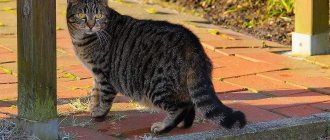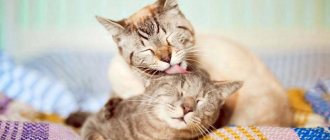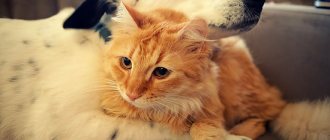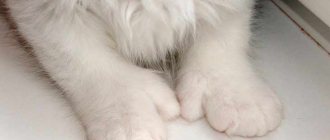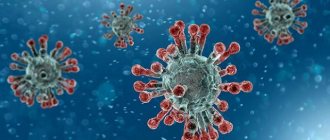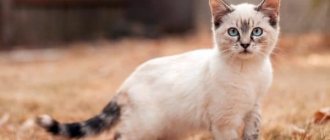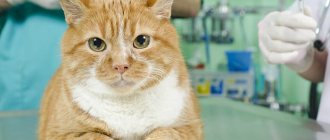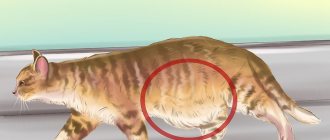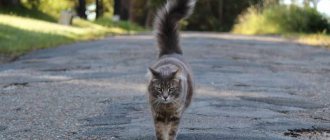A pitiful meow, vomiting or diarrhea in a pet takes you by surprise and forces you to look for the source of their appearance. In its location and role, the cat’s digestive system is similar to those of other mammals. Veterinarians clarify that regular cleaning, proper nutrition, cleaning the litter box and even providing spacious housing - all this will help protect the cat from gastrointestinal diseases and maintain its health.
What is a stomach pit
In fact, no pit is formed in the animal’s stomach. It’s just that the volume of the cat’s stomach becomes so large that it is difficult for her to feel full. The furry animal asks for food all the time. This happens for the following reasons:
- worms;
- childhood psychological trauma;
- distended stomach;
- excess weight.
If the last two reasons are closely related, then the first are treated with regimented feeding, medications and observation by a veterinarian. Since childhood, a kitten's stomach can stretch too much when the pet does not get food at the same time, steals food from the table, undereats, and then overeats. Some kittens do not feel full, but with proper feeding this will go away as they age.
Features and principles of proper cat nutrition
So, the main feature of the cat’s body is that it is 100% a predator. This means that in the wild, a cat eats exclusively meat, and not just any meat, but certainly freshly caught meat (unlike canines, which do not disdain carrion). The main prey of cats are rodents (mice, voles, jerboas and others), birds, less often rabbits and extremely rarely small fish. Therefore, the structure of all the cat’s organs (from claws to vision and smell) is adapted for hunting, catching, eating and digesting such food.
A cat can catch from 8 to 12 victims per day, and not always the first time, so it often returns to the hole or nest to try again. So the cat comes to its bowl in the house many times, demanding from the owner a portion of food and certainly a new one, even if there is still food left in the bowl. This is how the cat realizes its hunting instinct. Unable to catch prey, she uses a new hunting technique - extorting food from her owner.
Instinct tells cats to eat the caught rodent immediately, which is why cats prefer warm rather than cold food.
Another feature of cats is their incredibly developed sense of smell. The smell of food is of primary importance, which manufacturers of low-quality food successfully take advantage of by adding flavorings to food. By smell, a cat can determine not only the freshness of a product, but also its fat and protein content. Cats give preference to fattier foods, and animals are less attracted to vegetable fats. In addition, cats are well aware of the presence of the amino acid taurine in food, which is indispensable for their body and necessary for maintaining sharp vision and proper digestion.
Sensitivity to the taste of food in cats, on the contrary, is quite low. They do not taste sweet things at all, bitter things cause increased salivation, they are weakly sensitive to salty foods, but they like sour tastes.
Cats are conservative in the composition of their food. In the wild, the mother passes on her hunting skills to her offspring, and the prey that the kittens catch becomes the main diet for life. Therefore, the owner’s attempts to please his pet with a new delicacy are perceived by the cat without much joy. You can even argue that your cat will not only not be happy about changing food, but will be categorically against it.
An adult cat can be fed the same type of food for the rest of its life, and it will only be happy about it. Variety in food, of course, is required, but the cat does not accept this. During the complementary feeding period, kittens must be offered as varied a diet as possible. After all, it is impossible to determine exactly where the new owners of the kitten will live and whether they will be able to buy the only food to which you accustom the animal and only to which its intestines will be adapted.
How to feed an animal correctly
To avoid stretching your cat's stomach, you need to give food morning and evening at the same hours. Portions should also be fixed. Food must contain vitamins and minerals. If they are not enough, you should include vitamin supplements in the menu. When a cat has enough microelements, he does not attack food.
During pregnancy, the size of a cat's stomach increases due to larger portions. A pregnant mother must receive more food in order to safely bear her offspring. When a cat gives birth and feeds kittens, her portion must be gradually reduced to its previous size to prevent obesity and other diseases.
Digestion in animals
The process of searching for nutrients continues after food has been extracted, now inside the animal’s body, where it is digested, decomposing under the influence of gastric juices into simpler compounds, which then enter all cells of the body with the blood. Together with oxygen, they provide the body with the energy necessary for life. Plant foods are much more difficult to digest than animal foods.
Therefore, the digestive tract of herbivores is noticeably longer than that of carnivores.
In addition, most herbivorous mammals have a huge number of microscopically small bacteria in their bodies that help digest food. Cattle, antelope and deer digest their food twice. They regurgitate it and chew it again. This process is called chewing the cud. Hares and rabbits also eat their own waste products, so their food passes through the entire digestive system twice. In spiders and some other predators, the digestion process begins even before eating. They inject digestive juices directly into their prey.
The digestion process begins in the mouth. Here the food is crushed and moistened with saliva. Human saliva contains a substance called ptyalin that reacts with starch in food and converts it into sugar. Other digestive juices in the stomach and intestines break down proteins and fats. Each animal has its own special juices in its body, oriented towards the food it eats. Carnivores' saliva contains some ptyalin because their food contains very little starch.
Hoatzin bird
The hoatzin lives in the tropical forests of South America and is one of the few birds that feeds exclusively on foliage. The leaves are poorly digested and also have few nutrients, so you have to eat a huge amount of them. The elongated digestive system of the hoatzin leaves virtually no room for flight muscles. Due to their huge belly and small amount of muscles, hoatzins are practically unable to fly.
Insatiable caterpillars
Night and day butterflies are the last stage of development in the life cycle of these insects. They spend most of their lives as caterpillars, whose digestive system is noticeably larger than that of an adult insect. They are practically insatiable and store large food reserves that they need to develop into adult insects. Caterpillars do not have reproductive organs. Adult insects take care of reproduction, many of which do without food at all.
Ruminants
Cattle and other ruminants have very complex digestive systems. Their stomach consists of four chambers. Plant food is initially only lightly chewed and swallowed, entering the first chamber of the stomach, called the rumen. Here, with the help of bacteria, the process of leaf decomposition begins. Then the food is regurgitated in small portions and chewed thoroughly again. After this, the food passes through the remaining three chambers of the stomach and the intestines, where its digestion ends. This process continues for several days. Horses, donkeys, and zebras have much simpler digestive systems than cattle and other ruminants, although both have specialized bacteria needed for digestion. In horses and their relatives, the main part of the digestion process is carried out in an enlarged part of the intestine - the cecum, which is not as productive as chewing the cud.
Deadly saliva
Some snakes paralyze and kill their victims with poison so that they can then calmly eat them. Their venom glands are very similar to salivary glands, and the venom itself contains enzymes similar to those in human saliva or digestive juices. In the body of the victim, the poison has a double effect: it paralyzes it (in different snakes) and then slowly destroys the tissue structure. The enzymes in the venom are not enough to completely digest the food, but they help break it down after the snake has swallowed its prey.
Symptoms of kidney diseases
Attention! The first signs of disease appear when the organ is affected by 70% or more. For this reason, early diagnosis plays a huge role and significantly increases the chances of a positive outcome.
The main points that may appear at the onset of the disease are:
- weight loss;
- reluctance to eat;
- strong thirst;
- frequent urination;
- strong smell of urine;
- ammonia odor, most pronounced in the morning;
- decreased activity;
- faded wool;
- digestive disorders.
Signs of kidney disease in a cat
Symptoms appear at the following stages:
- fluid loss;
- frequent urination;
- painful sensations;
- increased protein levels in the urine;
- inflammations, ulcers;
- cracks in the mouth;
- weakness, drowsiness;
- pale gums;
- refusal to eat;
- nausea, vomiting;
- bowel disorders;
- weight loss;
- retinal disinsertion.
Diagnostics
The main diagnostic method that provides complete information is a urine test. An additional diagnostic method is ultrasound examination. During an ultrasound, the kidneys and urinary ducts are examined for the presence of pathological processes, stones, and sand.
Symptoms of urinary tract diseases in cats
If the results of a blood test and ultrasound reveal problems that require additional examination, the following are prescribed:
- biopsy;
- blood analysis;
- genetic research;
- virus detection;
- pressure measurement.
Based on the final diagnostic results, conclusions are drawn about the type of kidney disease, the stage of the disease and its treatment options. The most effective drug regimen is prescribed.
Video - Diagnosis and stages of chronic renal failure in cats
The danger of kidney disease
The danger is as follows:
- late diagnosis caused by the absence of symptoms in the initial stages;
- inability of kidney tissue to recover;
- the possibility of severe complications;
- the presence of a genetic predisposition factor in a number of breeds;
- males are prone to problems due to the structural features of their genitourinary system;
- high risk of death due to serious types of illnesses.
Only a veterinarian can prescribe the correct treatment
Common diseases
Kidney diseases pose a great danger. When there are serious problems, there is always the possibility that the animal may die.
Table. Common kidney diseases in cats
| Name of the disease | Emerging problems |
| Chronic failure | The gradual destruction of an organ, as a result of which the activity of the entire organism is disrupted. Stays with the animal for its entire life. Pet owners can only carry out constant maintenance therapy, avoiding exacerbation of the disease. The impetus can be any unfavorable factors (hypothermia, inflammatory diseases, metabolic disorders, etc.) |
| Acute failure | Unforeseen inflammatory process. There is a violation of the functions performed by organs. It develops rapidly and poses a greater danger than the chronic form. Common causes of the problem: heart disease, shock, drop in blood pressure, urolithiasis |
| Pyelonephritis | An inflammatory process of a bacterial nature. A common source of the problem is diseases of the genitourinary system |
| Nephritis | An inflammatory disease that affects the glomeruli, tubules, and interstitial renal tissue |
| Hydronephrosis | Enlargement of the pyelocaliceal system, destruction of the renal parenchyma. As a result, a pathological process develops, blood circulation is disrupted, and the outflow of urine worsens. All functions of the kidney cease to be performed properly. The problem can be primary or secondary. In the first case, the cause is the presence of congenital pathologies (for example, ectopia of the ureter). In secondary hydronephrosis, problems arise due to systemic diseases (urolithiasis, tumors, etc.) |
| Nephrosclerosis | The tissue of part of the kidney or the entire organ is replaced by connective tissue. There is a gradual death of kidney cells - nephrons. As a result, the organ greatly decreases in size, shrinks and hardens. |
The structure of a cat's kidney
